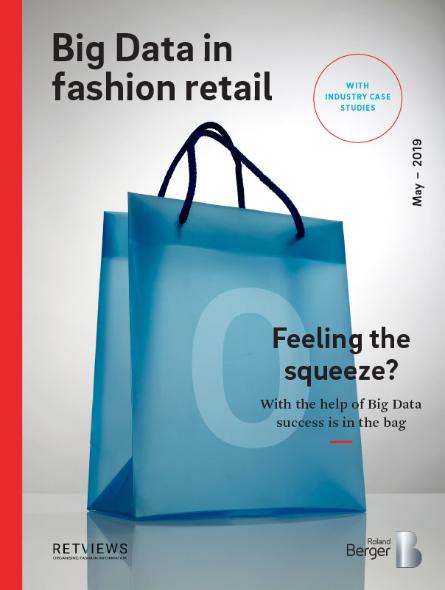Data analytics is a big deal for fashion retail
![{[downloads[language].preview]}](https://www.rolandberger.com/publications/publication_image/Roland_Berger_508_Digital_Lifecycle_Fashion_Cover_download_preview.jpg)
Big Data, properly analyzed and understood, can help fashion retailers transform the way they manage their business, from lifecycle management and inventory planning to pricing and discounts.


Times are tough in the world of fashion. Traditional fashion players are being squeezed between, on the one side, powerful vertical players and on the other, influential digital giants. Fortunately, help is at hand – in the form of Big Data. Technological advance over the past decade has put massive datasets at the fingertips of today's business leaders. That data represents an incredible resource that players can milk to gain insights into the fast-evolving fashion market. But the milking process isn't easy. Players need to develop the ability to handle and interpret this vast amount of data resource, or form alliances with partners that can help them find a way through the jungle.

"Big Data and data analytics have become key success factors. In the future, the use of Big Data in real time will be a strong differentiator for product development, marketing and omni-commerce."
Fashion companies are under pressure, with sales declining in key markets and prices being pushed down by low-price fashion labels. Shoppers are able to compare prices for a wide range of brands instantly with the help of online search engines and comparison sites, putting further downward pressure on prices. Discount brands have gained massively in popularity in recent years and online competitors have carved out a large share of the market. That leaves traditional players – especially brands that lack strong brand equity – in an unenviable position.
Big Data can prove a lifeline for such companies. Savvy players can use it in a wide range of areas in fashion retail. It can form the foundation for successful lifecycle management, keeping your brand image fresh while avoiding detrimental price erosion. It can revolutionize inventory planning, making your supply chain agile and helping you avoid the stock-outs that so disappoint customers. And it can inform your approach to pricing and discounts, helping determine the right pricing level and avoiding a downward spiral of markdowns.
Of course, collecting, processing and interpreting massive amounts of unstructured data isn't easy. Traditional companies would be well advised to build alliances with others in the industry, sharing their technology and cooperating in order to achieve scale. With this in mind, Roland Berger has formed a partnership with fashion analytics company Retviews, winner of the Best FashionTech Startup 2019 award. Retviews crawls the Net gathering millions of data points daily from more than 2,000 fashion retail websites in different countries. Roland Berger then uses this data as a basis for further analysis to derive insights and adjust organizational structures and processes to boost sales and margins.
Let's take an example. One significant area where Big Data can benefit fashion retailing is pricing. Driven by competitive trends, the length of time that items are offered at full price appears to be growing ever shorter. The result? A downward price spiral in the fight for market share. Notably, the data reveals that some players drive their business with almost half as many full-price references as their peers.
Our Big Data-driven analysis suggests that retailers need to identify adequate pricing levels and employ the correct timing to avoid markdowns later on. When discounting to clear the shelves of merchandise, you can use aggressive discounting. But you should do so for a limited period of time only, avoiding the temptation to engage in a discounting race with continuous markdowns as this will be detrimental to both your brand image and your margins.
Understanding ongoing market dynamics in this way can help traditional players to survive the pressure from both vertically integrated retailers and digitally-powered online players. Our recommendation? Make friends with Big Data. Properly analyzed and understood, it can transform the way you manage your merchandise, bring you closer to your customers, give you unprecedented insights into the behavior of your competitors and ultimately help you avoid being squeezed out of the market.

![{[downloads[language].preview]}](https://www.rolandberger.com/publications/publication_image/Roland_Berger_508_Digital_Lifecycle_Fashion_Cover_download_preview.jpg)
Big Data, properly analyzed and understood, can help fashion retailers transform the way they manage their business, from lifecycle management and inventory planning to pricing and discounts.